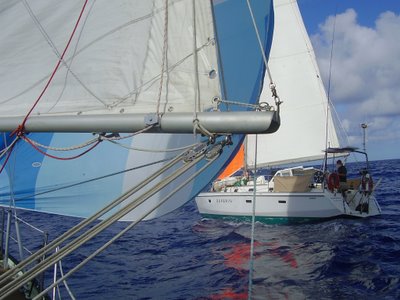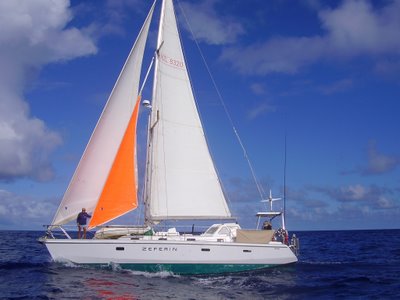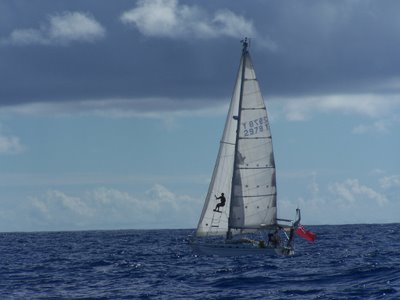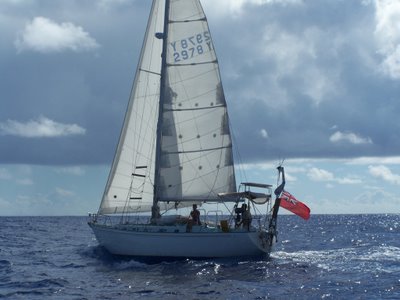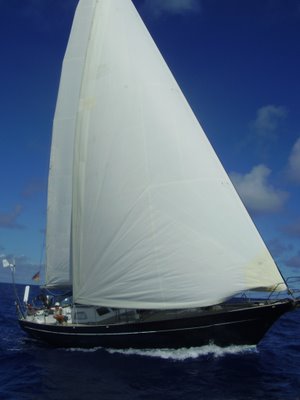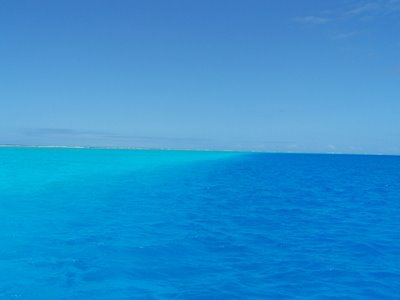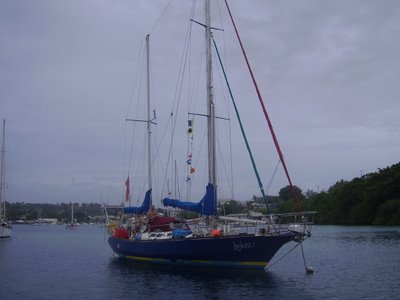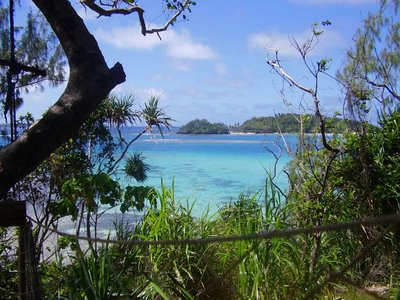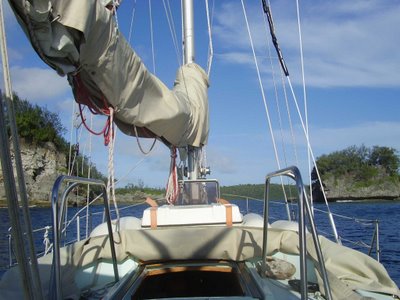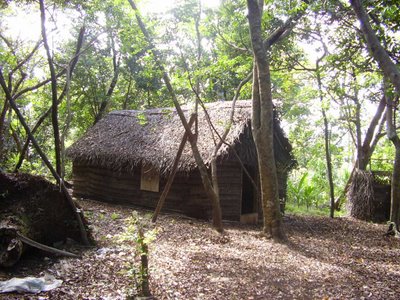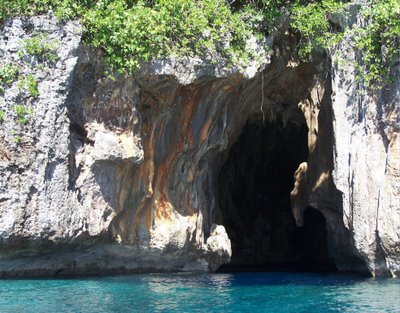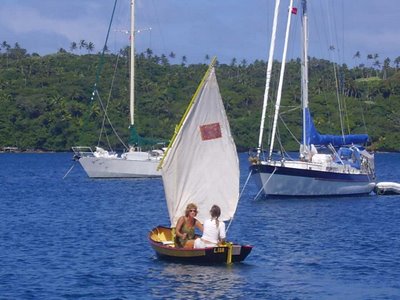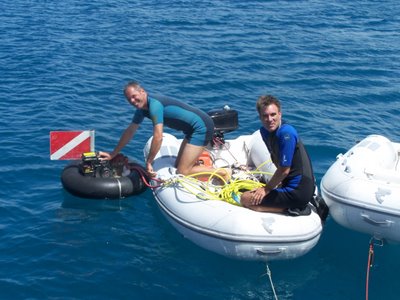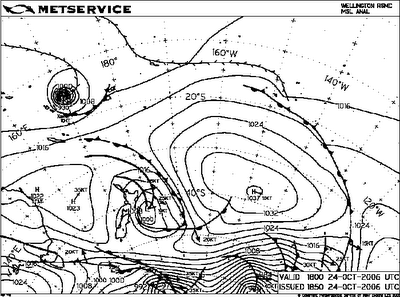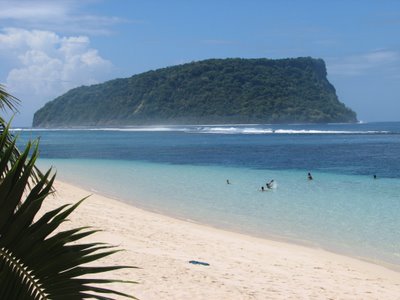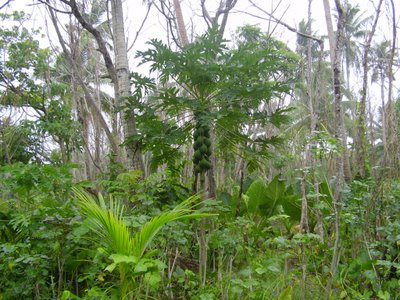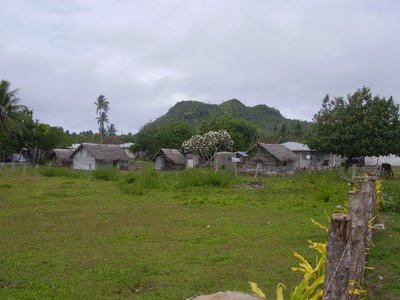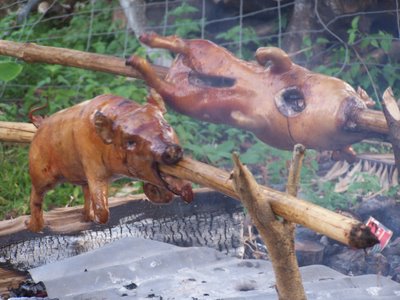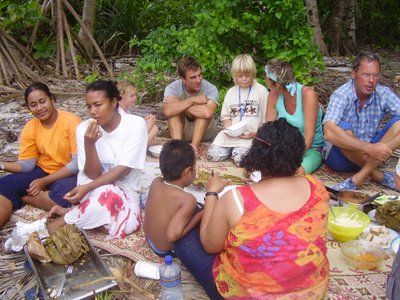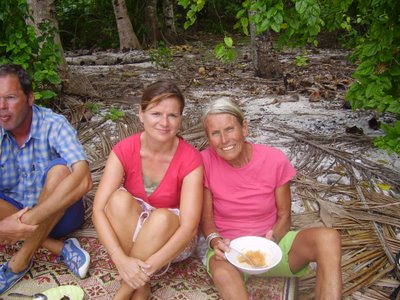Apia gave us the chance to restock after eating and trading most of the edible items on-board in Penrhyn and during the 1400+ mile passage from Bora Bora. For the first time we took on bonded stores - the best deal was “Potter's premium rum” at just over £2 per litre - even if we end up using it to light fires we feel we've got a good deal.
Samoa felt like a return to civilisation again and fortunately an affordable civilisation after the ruinous cost of French Polynesia. It's surprising how quickly initially startling sights become assimilated and so it was for the Samoan male outfit - the lava lava or ... skirt. Surprise quickly gave way to admiration for the elegance and practicality of the outfit. Why have women kept this secret from men for so long? Isn't David Beckham a closet skirt wearer? Perhaps its worth while following Beckham's clothing innovations - where does Ellen keep those "Hello" magazines....?
As well as taking a trip round the island, hiking to Robert Louis Stevenson's grave, sampling the bars and restaurants, and finding our way round the veg market, our time in Apia was enjoyably sociable. We were reunited with Zeferin, and Revision II our Pacific crossing partners as well as Noa and Quantum Leap our companions in Penrhyn. Zeferin had been stuck in Apia for two weeks already, waiting for engine spares. They were ready to leave when Sandy was immobilised by a coral infection which quickly spread throughout his leg and it took the island's strongest antibiotics to return him to his usual sprightly self. Ellen spent time with Zeferin's grand-children, snorkelling amongst huge clams in a nearly marine park while I made progress with some more pressing boat jobs.
The "award winning" "Samoa Observer" is an English language paper which we bought in the hope it would give some insight into island life. Lead stories included:
- Death of the Tongan King Taufa'ahau
- Crack down on buses playing music too loudly
- Much debate over whether the recent anointed Miss Samoa should be stripped of her title when she turned out to be a day under-age.
- 341 days to go to the South Pacific Games to be held in Samoa - see www.samoa2007.ws
- An intriguing report titled, "PM ask UN defer LDC graduation" which transpired that the prime-minister had asked the UN to allow Samoa to keep it in the group of "Least Developed Countries" the report infered it was so Somoa could still access cheap loans.
Not sure we gleaned a completely rounded view of life in Samoa, but at least we knew we could use public transport without being deafened. For a few days the headlines were taken over with "Shock Over Dinghy Theft". A couple of dinghies went missing one night and some skilled media manipulation by the owners meant that there can't have been many Samoans who hadn't heard of the loss of the "pelangis'" (Westerners') dinghies. All ended well when the police found them ten miles down the coast, but left us with mixed feelings, pleased for the owners, but somewhat guilty at the way in which a large operation had been mobilised for tourists, presumably to the detriment of the locals.
One evening we headed out to a Aggie Grey's, a famous local hotel, to see some "traditional" Samoan dance. Normally this isn't the kind of thing we search-out, but a reasonably priced eat-as-much-as-you-like buffet proved too much to resist. I went with added trepidation as I spent a disproportionate period of my student days in a pub named Aggie Grey's. Fortunately the Samoan Aggie Grey's as well as being physically half way round the world was also as far removed from its Southampton namesake. Beautiful dancing in a stunning hall provided the backdrop for the food. We tried the local delicacies; taro leaves with chicken, sea urchin roe (tasted a little of oyster), local clams – all pretty good and they provided us with more ideas for our 'hunting-gathering' trips. A good evening that, like in my student days, took us a day to fully recover from.
In Apia we started a second front on our resident cockroaches. Our first campaign in Polynesia appeared to have been a success, but it transpired that a new generation had been laid and were waiting for us to drop our vigilance before emerging. We searched the town for WMCDs (weapons of mass cockroach destruction) and returned armed with a new can of Mortein, "now with egg kill" and 24 "Lure'n Kill" cockroach baits. All have been deployed and we're spotting an increasing number of dead cockroaches, but are planning a cockroach bomb in New Zealand which will leave the boat uninhabitable for 24 hours; hopefully for the roaches as well as us.
We finally dragged ourselves away from Apia at 9.30 on 24th September for the 190 mile trip to Nuitoputapu, the most northern Tongan island. We planned to arrive before dark the following day which would mean we'd need to average around 6 knots. We set off well with 20-25 knots easterly wind and Kika comfortably making 6.5 knots with 2 reefs in the main - perfect conditions for making landfall before dusk. However the plan quickly started to unravel when we reached the west point of the Upolu and found ourselves with a counter-current creating a disturbed sea and head-winds, reducing our speed to less than 4 knots made good. Rather than continue to beat into the wind we decided to burn some of our duty-free diesel and motored for a couple of hours until we were out of the lee of the island. Slowly the wind backed to the SE and picked up, and now under full sail we made 4.5-5 knots towards our destination. At our 6pm radio schedule, we had 149 miles to go and little sign of more wind so it looked as though we'd have to spend another night at sea. Fortunately the wind continued to increase until the early hours when it settled to a steady 25 knots, although the ferocity of the squalls continued to increase and we ended the night with 3 reefs in the main and a much reduced genoa beating into a large sea but making a good 7 knots towards Tonga. By our 7am radio schedule we had 65 miles to go, and were looking good for a day-light landfall. The wind continued to play tricks; veering to the south, so we couldn't lay our course to the island, but eventually backed again so we could ease the sails slightly to a fine reach. It all felt a little like a hard beat across the Thames estuary although at least the regular drenching was pleasantly warm. We arrived at 6pm wet through, wind-beaten and deafened but elated to be in before dusk.
Our trip had taken us across the dateline, Samoa uses UT-11, Tonga UT+13. We'd set off on Sunday morning the trip took 32 hours but arrived Tuesday evening, we lost a day and a not a bad day to lose if it was anything like the preceding day.
Noa and Zeferin arrived the next day, after a harder trip than ours; they had winds gusting up to 45 knots and looked thoroughly shattered. We were welcomed into the lagoon by turtles and the crew of Quantum Leap.
Our first sample of Tonga was mixed; a beautiful island, with three villages and much cultivation, but it appeared to be the least developed of all the islands we've visited. The island supply ship was a month overdue and supplies were starting to run low, although with the profusion of fruit and fish I doubt anyone was going to starve.
Many of the huts in the village are built from local materials, there were pigs running around the village and whales blowing outside the reef.
It should have been idyllic, but somehow the continued wet weather, our weariness and the friendly reserve by the Tongans meant we didn't fully engage with the people in the way we had in Penrhyn. That said we were invited to a barbeque and a Sunday "pot-luck" on a motu. The barbeque consisted of two piglets on a spit, roasted over a fire and some largely inedible (at least to our palates) taro.
The resulting pork looked great, and some of the meat was deliciously tender, but the vast majority was a little too fatty – perhaps we've just been spoilt by too much fresh sea-food.
For the motu "pot-luck" we thought we should take sufficient of our own offerings to ensure we weren't forced by hunger into trying taro again. We took a mango tart (mangoes from a 'hunting-gathering' trip), falafel and coleslaw.
In addition to the taro offering we were treated to stewed papaya and fish soaked in coconut juice with taro leaves, wrapped in banana leaves and baked in an omu (a pit filled with embers, in which the parcels of food are buried), both delicious.
On our second evening we felt a strange vibration through Kika, as though she'd suddenly turned to jelly and was being shaken from the bow. The following day we learned there'd been a large (6.5) undersea volcanic eruption a couple of hundred miles away. A tsunami warning had been issued but thankfully withdrawn. We'd heard stories of islands appearing and disappearing in this area, and the chart has caution areas marked “warning volcanic activity reported 2001”. Something to avoid.
During our stay in Nuitoputapu, the 180 mile trip due south to next island group was never far from our minds. A southerly wind continued to howl through the anchorage and many of the boats had been stuck waiting for an easterly shift for over a week. We didn't fancy another battering like the one we'd received from Samoa so much time was spent discussing the outlook and examining the forecasts. Eventually the winds shifted to the east and then to the north which was too good an opportunity to miss. So Sunday night was spent preparing for an early Monday departure. I spent the night listening to torrential rain and fretting over the passage south. The rain cleared in the morning but left the dinghy half filled and barely floating. An overflowing bucket indicated over 10 inches of rain. Before leaving we need clearance for Vava'u. Tonga is one of the countries that requires yachts to obtain clearance between island groups. We thought we arranged for Bessie, the local customs official, to arrive at 9.30 to give us the paper we needed. By 10.30 we called and were assured that she'd be there by 11. At 11.30 we called again, all knowledge was denied of previous arrangements, but she kept her third promise and arrived just after 12. This delayed our departure until 1pm and meant we had little hope of making Vava'u before nightfall the following day. My mood was blackened further when the exhaust sprang another leak as we left and I was reminded of my previous frustrations attempting repairs. However the clouds had cleared, the water around in the reef looked magnificent and a whale and calf put on a spouting and tail slapping display as we cleared the northern end of the island.
The northern wind was light, meaning we were making around 5 knots for most of the day, but with little chance to arrive before dark. Fortunately Sandy has sailed in Tonga a couple of times before and knew an anchorage which was relatively coral-free and should be possible to enter with a good moon and judicious use of radar. Given our speed our ETA was around 2am. Then at 4pm the wind shifted rapidly to the south. The unusual northerly wind was being caused by a low pressure system south of Tonga, this system was moving east-wards and would eventually bring the wind through the south before the standard SE flow re-established itself. However we didn't expect it to happen so quickly. At our 6pm radio schedule, Noa were just arriving, they'd set off four hours before us having extracted their clearance on Friday, but Zeferin and us were left with head-winds and a frustratingly close 45 miles to go. We cursed Bessie as we tacked back and forth all night making barely 15 miles towards Vava'u for all our efforts – we appeared to be affected by an adverse tide and we've yet to perfect tuning the self-steering to steer as close to the wind as we'd like.
This morning with 30 miles still to go, and a dying wind we decided to test my latest exhaust fix and motor the rest of the way.
At the time of writing (11.00am) we have 12 miles to go and no signs of asphyxiation.
